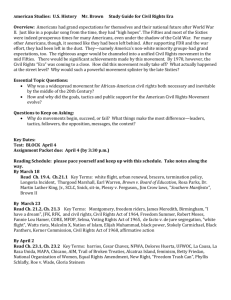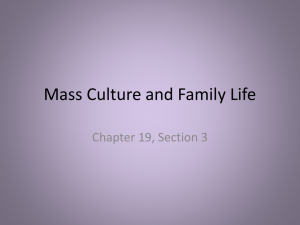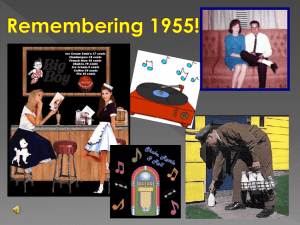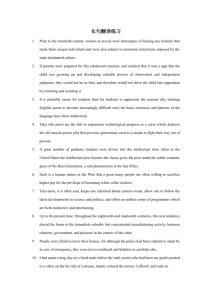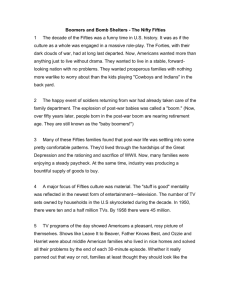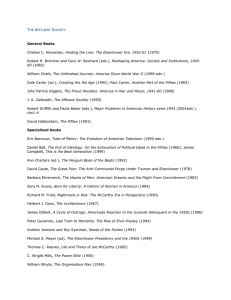Historiography of the 1950s Zachary May Dr. Cary Roberts HIST 501
advertisement
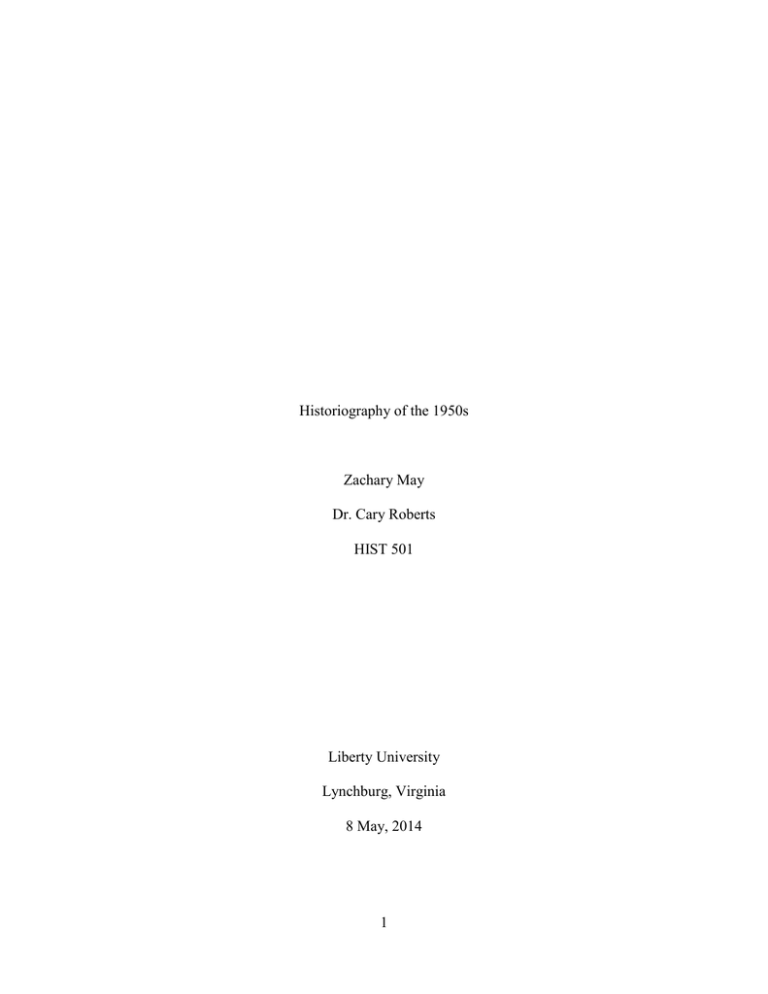
Historiography of the 1950s Zachary May Dr. Cary Roberts HIST 501 Liberty University Lynchburg, Virginia 8 May, 2014 1 Americans present different images of the fifties. Two popular images that emerge consist of fear and anxiety, while the other deals with the nostalgia and comfort. The United States entered the decade with a wave of uncertainty. The forties brought the nation from an economical lull to a nation with the biggest economy in the world. Through five years of war, the United States replaced Great Britain as the world’s police. With added pressures, the United States foreign policy challenged the Soviet Union and Communism. Socially, the late forties witnessed the presence of the baby boom generation. This generation will have a major impact economically in the fifties and socially in the sixties. Overshadowed by an ideological war between two former allies, the final years of the forties brought anxiety and conformity. The rise of the new decade brought new a sense of anxiety and the unknown. The fifties witnessed conflict, conformity, prosperity, and anxiety. The Korean War brought the reality of its new status in the world’s hierarchy. The wheels of war produced feelings of patriotism and support 2 for President Harry Truman. In the early fifties, the political atmosphere was rife with anticommunistic sentiment. Throughout the decade, McCarthyism effected politicians and workers in the entertainment industry. Named after Wisconsin Senator, Joseph McCarthy, McCarthyism symbolized the fear of communism that rattled American life. By 1952, the Republican candidate Dwight D. Eisenhower defeated Democratic nominee, Adlai Stevenson, to enter in a decade of conservative policies and hard line diplomacy. During the decade, an innovation, the television replaced the radio as not only a form of entertainment, but for an outlet of news. The movie industry, challenged by television, reinvented itself, challenging social mores. Films, such as A Streetcar Named Desire, A Rebel without a Cause, and Blackboard Jungle challenged the status quo and represented the social ferment that ran the new youth generation. In the late fifties, the Cold War dominated the political realm, and with the launch of sputnik and the U2 spy plane incident. By the end of the decade, new liberal politicians, including John F. Kennedy and Lyndon B. Johnson prepared for their turn in the White House. With the rise of the sixties, historical debate has awakened new theories of and schools of thoughts. Thoughts of anxieties, nostalgia, women’s rights, and innovation highlight the historiography of the fifties. Historians struggle to fine continuity in their opinion of the decade. The spectrum of thought stretches from anxiety to prosperity. From synthetic works to more topic base works, the views have only furthered its complexities. In the early sixties and seventies, the New Left school argued for the decade’s anxieties and fear as the main themes. The traditional view approaches the fifties as a decade built on the back of the World War II generation. Their focus and labor transformed the United States into the nation it is today. During the mid-nineties, the Halberstam school of thought, a new group of historians and journalist, looked at the fifties as a decade of innovations and social ferment. In the late sixties to now, the New Social School of 3 thought, tries to give the minorities and women its rightful place. Scholarly research today focuses not only on the social aspects of the decade, but on the lesser known figures and events that occurred. When starting the analysis on fifties historiography, one has to start with the traditional view. Traditionalist View Two views dominate fifties historiography, one deals with anxiety and the other focuses on nostalgia. The view of fifties as a prosperous decade not only resonates in educational textbooks, but also in film and television. The image of the All-American family permeates in the minds of many. The housewife in her apron, the dad in the business suit, and the kid wearing a baseball hat still resonate to today’s family. Television shows including Leave it to Beaver, The Adventures of Ozzie and Harriet, and The Andy Griffith Show displays the mechanics of the traditionalist view. The traditionalists view the decade through a positive lens, focusing heavily on the World War II generation and their effort in transforming the nation into the status it bears in modern times. They would argue that prosperity of the fifties was not entirely due to the outcome of World War II, but on the participants whom blended back in American society. Their willingness to achieve greater goals and wealth ushered in a new mentality that generated results. The nation they transformed rested on their willingness to peruse a secondary education and a moral foundation. The traditionalists view is cemented on the memory of America due to the help of television and film. Even though cinematic arts propelled the image, historians and journalists furthered the ideological thought. The traditionalists view has been prevalent since the sixties, but it was Tom Brokaw’s The Greatest Generation, which inspired further interest in the fifties. Tom Brokaw, a journalist and broadcaster, has frequented American households since the seventies with his nightly news 4 show. Through his medium of television, Brokaw had the opportunity to travel the globe. Through his travels, he has had the opportunity to meet many World War II veterans. Through his many occurrences with the veterans, his interests and appreciation soared. His appreciation did not equal a biographical look at a generation, but it furthered his fascination. It was not until sixtieth anniversary of the Normandy Invasion, that his appreciation turned into an intense desire. Through many interviews and extensive research, Brokaw’s The Greatest Generation entered academia and public in 1997. In The Great Generation, Brokaw tells the story of the World War II generation and their adventures after the war. He details how a generation accepts their task at fighting a two front war, then comes back and transforms society. Through secondary education, veterans entered the world of entertainment, politics, and economics. They transformed the nation’s war economy to a prosperous peacetime economy, challenge communism across the globe, and made breakthrough in medicine and science. Although he praises the post-war generation, he understands the mistakes they made. Their slow reaction to civil rights and the acceptance of McCarthyism is a minor stain on their record. His integral work inspired similar results from other historians. Suzanne Mettler’s Soldiers to Citizens: The G.I Bill and the making of the Greatest Generation is a traditionalist’s view on the post-war generation and their relationship with the G.I Bill. Where Brokaw looks at the fifties through a biographical scope, Mettler examines the decade through an integral governmental program. The G.I bill authorized the payment of veterans housing, but most importantly, an opportunity for education. Her argument is twofold, the bill fostered an added trust between the government and the veteran, and it produced a political renaissance. With the opportunity for an education, World War II veterans felt the compassion and thanks that the government felt. Many veterans whom participated in the G.I 5 bill’s educational program, ventured into politics. Names including Bob Dole and Mark Hatfield were only but a few whom entered the realm of politics. Mettler and Brokaw did not invent the traditionalist view, but they broadened it by analyzing the World War II generation and their impact on the nation. Unlike the Traditionalists, a new school of thought emerged in the sixties, challenging the peaceful middle class society. Marxist and New Left View The fifties not only resonated thoughts of nostalgia, but also feelings of anxiety and fear. Fuming in the background of middle class society was the ideological war between the United States and the Soviet Union. One cannot address the fifties without mentioning the Cold War. In the sixties and the seventies, many Marxist and New Left historians focused on this fear and anxiety that Cold War and the Civil Rights movement produced. Their view addressed the conflict that was prevalent. New Left historians questioned the intentions of American diplomacy and became skeptical of the Government. They also try to view the fifties through the eyes of the non-white male. Works on the difficulties of race and gender during the decade echo their sentiment. The issue with Marxist and New Left historians revolves around their passions they bring to their work. If it spans from their research or their opinions, their ideology has the ability to alter their results. Although their ideology can be problematic, their desire to question the status qua and analyze the forgotten individual are admirable goals. Marxist and New Left writings first appeared in the early sixties with the work of William Appleman Williams. Williams, A historian at the University of Wisconsin, explores America’s diplomatic history and examines the discrepancies in their ideology. In Tragedy of American Diplomacy, Williams displays a pessimistic view of America’s intentions in foreign policy. He argues America’s fault in escalating the Cold War. He notes America’s displeasure in 6 militant-diplomacy, but argues that their foreign policies ultimately led to conflict. Similar to Williams, Gabriel and Joyce Kolko focus solely on America’s diplomatic intentions. In The Limits of Power: The World and the United States Foreign Policy, the Kolkos argue that the United States intentions in diplomacy focused on economics instead of morality or political reasoning. Like Williams, the Kolkos further argue that America’s interventions into areas including Iran and Guatemala were focused not on the protection of their citizen but on America’s businesses and business expansion. Where Williams and the Kolkos focus on diplomacy, leftist historian, Howard Zinn analyzes the history of America from Columbus to Clinton through an almost Marxist view. Through his historical analysis, he gives voice to the individuals once forgotten, including women and minorities. He looks at events from a participant against elite view. Through his ideology, A People’s History of the United States presents a negative view full of conflict. His analysis on the fifties ring to the Marxist sentiment of fear, anxiety, and turmoil. Skeptical of the government, he argues that the American government used the Cold War as a way to control the American people. He also hints at the United States using the Civil Rights movement as a tool to combat Soviet propaganda. Although Zinn presents a rather pessimistic or almost a nihilist view on the government’s actions in the fifties, his desire to show the history through the eyes of the unheard voice is what sets his work in almost a thought of himself. Similar to the Marxist and New Left view, a new school of thought emerged in the nineties that questioned the traditionalist view. Halberstam View In the nineties, the Halberstam school of thought questioned the traditionalist view of the fifties. The Halberstam school of thought does not challenge the traditionalist’s positive view; they delve deeper in analyzing the innovations and ferment that presided in the fifties. The 7 school of thought borrows views from both the traditionalist and Marxist camps. Historians of the Halberstam school shares the traditionalists view of a prosperous Post-World War II generation and borrow the Marxist view of analyzing social ferment that occurred. There scope of the decade is a positive one, where their goal is to analyze the period through a non-bias viewpoint. Where other schools focus on one segment of the fifties, such as through economics or politics, Halberstam historians utilize all focuses to present a different image. The Halberstam School separates itself from other schools through its emphasis on new innovations and social ferment. They tend to see events that occur in the fifties as a precursor to the social revolutions and movements that occurred in the sixties and seventies. The integral work from the Halberstam school of thought comes from David Halberstam. Halberstam, a respected journalist and author, presents a synthetic work on the fifties. Starting his career as a journalist in Mississippi in the fifties, Halberstam presents a realistic and personal view. His journalistic past shines through with his analysis on the early Civil Rights Movement, which he covered when he was a reporter. His collection of sources and recollection of experiences led to his integral work, The Fifties. In his work, he begins his analysis with the Truman presidency and ends with the rise of John F. Kennedy. Between these two presidents, Halberstam explores the important events and themes. The Cold War, the Hydrogen Bomb, rise of television, the Civil Rights Movement, the Eisenhower Presidency, General Motors, and the rise of advertising fill the pages of his work. Similar to Tom Brokaw, Halberstam highlights the Post-World War II generation’s impact on the decade, but he does not dwell on them. Through his research, he views the fifties as the decade where the moving image replaced the written word as the way an individual received the news. He also magnifies the seeds of social ferment 8 that led to the tensions of the sixties and seventies. He highlights events, such as the birth control pill and the Emmett Till saga to show the tension that was forming. Similar to Halberstam’s work, Fred Kaplan explores the events of the late fifties to show its impact on modern society. In, 1959: The Year that Changed Everything, Kaplan argues that the events that occurred in 1959 altered the United States into the modern era. Similar to Halberstam, Kaplan finds the beginning of the modern era in the fifties. He highlights the invention of the computer chip, the rise of Vidal Castro, and the end of obscenity laws. He also revises the traditionalist’s view of the fifties, by describing social ferment that Halberstam left out. Kaplan’s analysis on the Beat movement and their impact on the obscenity laws is a microcosm of his overall thesis and purpose. Where Halberstam and Kaplan look at the fifties through several lenses, James Gilbert and Peter Kuznick strictly analyze the decade through a cultural lens. In Rethinking Cold War Culture, James Gilbert and Peter Kuznick argue that fifties culture was anything but the boring and homogenized decade portrayed in television and film. The edited work is compilation of essays, each arguing for a different view of decade. These Halberstam historians all try to show the fifties as an exciting decade that resembles more the sixties then the depictions television casts. Where the Halberstam school of thought looks at the bigger picture, a new school of thought goes more in-depth to explore the decade through the eyes of the forgotten. New Social History View Starting in the sixties, the New Social History originated and continues to affect the historiography. The New Social History school of thought focuses on the fifties through the eyes of women, minorities, and homosexuals. Influenced by the New Left view, they avoid the allwhite male view and focus on the lesser-known voices. New Social historians have a tendency of 9 providing a negative view of the fifties. Although the decade brought prosperity to many, there were segments of society, which faced insecurity and discrimination. Unlike the Marxists or the New Leftists, New Social historians try to present a positive view of the American government. With that said, some social historians’ agenda and ideology do in fact alter the realities of their thesis. This school of thought is popular since it gravitates toward the untold stories left out in synthetic works. One of the leading feminists of the twentieth century wrote the most distinguished work of the New History School. Betty Friedan, a feminist, was instrumental in not only the feminist movement, but also the sexual revolution. With her support for the birth control pill and Roe v.Wade, Freidan propelled women’s rights to the national level. In The Feminine Mystique, Freidan explores the realities women faced in the fifties. She discovers the hopefulness and misery the average woman faced. Freidan discredits the June Cleaver stereotype and challenges the idea that women are supposed to live through their husband or children’s experiences. It started with Freidan’s work, but her protest filtered down to other social historians in the fields of gender or Civil Rights. The importance of Betty Freidan reaches beyond her Feminine Mystique and lies in her impact on other New Social historians. Her impact can be seen in several major works. In The Way We Never Were: American Families in the Nostalgic Trap, Stephanie Coontz shatters the stereotypical view of the family in the fifties. She further argues that families have always been in an influx and in a stage of crisis, and the fifties were the same. Coontz points to a spike of unwedded teenage pregnancies in the fifties to show crisis in the family. Her work is not negative, but a reality which she uncovers. Similar to Coontz, Joanne Meyerowitz tries to silent the June Cleaver stereotype and presents the realities of being a housewife in the fifties. Her 10 compilation, Not June Cleaver: Women and Gender in Postwar America, 1945-1960, offers different sketches of women and the struggles they faced. To offset the women’s’ studies, James Gilbert’s Men in the Middle: Searching for Masculinity in the 1950s offers a fresh look at the role of men during the fifties. He tries to show how men were not confined to the image of a ‘men in the gray flannel suit’. The New Social History thought is so wide that it covers more than the spectrum of women in the fifties. The thought covers minorities, orientation, and culture. In Michael Klarman’s Brown vs. Board of Education and the Civil Rights Movement, he revises the once held notions of the Supreme Court Case, Brown vs Board of Education. He challenges the notion that Brown vs Board of Education occurred in a vacuum and the view that the decision inspired the civil rights movement. Klarman argues that the Civil Rights movement would have occurred with or without the court’s decision. He also argues that the decision hurt the by causing intense backlash from the South. Klarman uses the same methods that Social Historians use to give the unheard a voice. Social historians tackle race through different means. Where Klarman tackles race through the judicial lens, Penny Von Eschen looks at race through the lens of diplomacy and culture. In Satchmo Blows the World: Jazz Ambassadors Play the Cold War, Von Eschen details the use of Jazz musicians by the government to oppose soviet propaganda. The idea is similar to Zinn’s argument of civil rights as a tool against soviet diplomacy, but it differs in that the Jazz ambassadors would not be qualified as part of the Civil Rights Movement. He details the travels of Jazz ambassadors into third world countries to silence the rumors of racism in America. Similar with race and gender, Social historian tackle the cultural side of the fifties. A newer work shares certain Marxist and New Left ideology in its premise. In Devil in the Grove: Thurgood Marshall, the Groveland Boys, and the Dawn of America, Gilbert King highlights an event 11 overshadowed by the Civil Rights movement. After the war, the South became vulnerable to racial change and Gilbert’s analysis on the Groveland boys capsulated that idea. The work focuses on a racial case involving two black WWII vets accused of raping an impoverished poor white women. The work shares Marxist views in two ways; its highlights the apathy shown by the state and National government on action in favor of African Americans and its focus on the minorities. Although it shares Marxist views, it drifts away since Gilbert’s desire is not to show the ineptitude of the government, but the hostility of the South. History on race is nothing new, but Social Historians give a new breadth into the events and personalities that participated in them. Personalities such as Thurgood Marshall, Emmett Till, and Rosa Park, and even Harry Truman are given credence in creation of the Civil Rights. Social historian who focus on cultural, revise the once held notions that fifties American culture. To contradict the Marxist view of the Cold War being the cause of anxiety, Lee Bernstein argues that it was Organized Crime, which was the trigger. He argues that organized crime played a big role in American fifties. Although revisionist history plays a part in the New Social History, analysis on culture dominates the current works. In Seeing is Believing: How Hollywood taught Us to Stop Worrying and love the fifties, Peter Biskind explores the cinematography of the fifties to show the hidden themes that occur. Movies including Invasion of the Body Snatchers, Giant, and On the Waterfront may seem harmless, but in reality carry an ideological burden. The decade saw the rise of McDonalds and the idea of quality at a fast pace. In Fast Food Nation: The Dark Side of the All American Meal, Eric Schlosser explores the fast food industry by using the Upton Sinclair approach. Although he uses the investigative journalistic approach of the Progressive era, he examines the rise and popularity of McDonalds and other fast food giants during the fifties. In general, Social Historians borrow from the 12 Marxist viewpoint to explore the unheard voice, and it shares the Halberstam thought of examining the social ferment. Majority of the scholarly work being published by University presses would qualify as the New Social History. Culture in the 1950s The historiography of the fifties contains a major amount of scholarly work on culture. After the war, the average American family income increased, causing a trickle down approach into the hands of this new youth generation. In Race, Rock, and Elvis, Michael T. Bertrand highlights not only the rise and controversy of Elvis, but also the rising youth generation. He highlights the rise of Elvis’s records and the desegregation of Presley concerts as examples of the power the youth generation had. Where Bertrand looks at fifties culture through the circus of Elvis Presley, William H. Young presents a synthetic work on the decade’s culture. In The 1950s: American Popular Culture through History, Young present the norms of fifties cultures, but uses the Halberstam view on the social ferment. From the rise of Rock n Roll to Tennessee William’s playwrights, culture took a noticeable rebellious tone. Although he analyzes social ferment, he does present a nostalgic view. The presence of advertising and consumerism focuses on this new youth generation is noticeable themes in Young’s work. The presence of comic books, hula hopes, and Slinkys where advertised strictly for children, which displays the power the youth had. To give a more realistic approach on culture, Bill Bryson’s autobiographical work, The Life and Times of the Thunderbolt Kid: A Memoir, highlights the youth generation and their needs. From comic books to Rock n Roll records, Bryson’s childhood symbolizes the majority. Politics of the 1950s The fifties saw changes and transformation in the political arena and the voters themselves. The decade witnessed only two presidents, whom both acted with a steady fist. 13 Harry Truman and Dwight D. Eisenhower both symbolized the capitalist sentiment by challenging communist Russia wherever necessary. The scholarly sentiment of the decade has focused on these two personalities. Truman’s Presidency has been marred in negativity and controversy. In Truman, David McCullough challenges the widely held view of Truman as a corrupt leader. He looks at Truman as a decisive decision maker and the perfect personality to handle the beginning of the Cold War. He does criticize Truman on his past allegiances. McCullough discounts the stereotypes and finds Truman as a man of high standard. The guilt revolves around his support of cronies, such as Tom Prendergast of the Kansas City political machine. Although McCullough’s work is primarily focused on Truman, he analyses the early fifties to give further context. McCullough focuses on the early fifties and highlights the growing conservative movement as a backlash to the twenty years of New Deal legislation. Stephen Ambrose highlights the growing conservative movement of the fifties through the legacy of Dwight D. Eisenhower. In Eisenhower: Soldier and President, Ambrose shatters the view of Eisenhower as a do-nothing president. Through numerous research, he uncovers an unseen part of Eisenhower that the majority of American did not see. Eisenhower worked behind the scene to further civil rights and the Cold War. In the political realm, much work has been devoted to the South. In The Rise of Massive Resistance: Race and Politics in the South during the 1950s, Numan V. Bartley display the political rebellion against the Government’s efforts of desegregation. Through fear and contemplation of the abolition of the Public School system, Bartley highlights the tactics the South initiated. Political scholarly on the fifties represent the tensions and personalities that lived during the era Religion in the 1950s 14 Recently, there has been a steady flow of historical research on Religion and its relationship with the fifties. The decade saw the rise of televangelists, the reemergence of crusades, and the explosion of collegiate religious organizations. Billy Graham, Bill Bright, Martin Luther King Jr, and Malcolm X are only a few man of faith who challenged the norms of the fifties. Although names including King and Graham are recognizable, one of the more popular pastors was Norman Vincent Peale. In Gods Salesman: Norman Vincent Peale and the Power of Positive Thinking, Carol R. V. George introduces the reader to a pastor rather forgotten. George emphasizes Peale’s idea of positive thinking and its context to the fifties. Although his name does not resonate as Grahams or Kings, Peale’s popularity in the fifties was integral. Another area where religion had an impact occurred on college campuses. In Bill Bright and Campus Crusade for Christ: The Renewal of Evangelism in Postwar America, John G. Turner describes the emergence of Bill Bright and the creation of Campus Crusades for Christ. Although Turner looks at Campus Crusades doctrinal beliefs, he focuses on Bright’s marketing and advertising strategies. It is Bright, Turner acknowledges, who made evangelism into a subculture of its own. Similar to Bright and Peale, Billy Graham became a household name that inspired and counseled Presidents. In Billy Graham and the Rise of the Republican South, Stephen P. Miller studies Graham from a different perspective. Instead of analyzing Graham from the viewpoint of his relationship with the Presidents, Miller focuses on his connection with the South and the affiliation between popular evangelism and Conservatives. Another religion that saw a rise in the fifties was Islam. With the rise of Malcom X, Islam became a force. In Malcolm and the Cross: The Nation of Islam, Malcolm X, and Christianity, Louis A. Decaro Jr describes Malcolm X’s relationship with Christianity. He does not evade Malcolm’s Islamic faith, but looks at his sympathetic views on the Christianity. Decaro Jr does not avoid Malcolm X’s use of 15 violence in retaliation against segregation, but looks into his personal thoughts on religion. Religion in the fifties saw a tumultuous rise with the coming of television. Religious personalities became more than just a message of God, but a voice of reason, protest, and change. When the sixties came, America was on course to the modern form it is today. Traditionalists acknowledge it was the Post World War II generation whom altered the course of twentieth century America. It was their willingness to further their education and their desire to succeed which transformed the economy and made breakthroughs in the sciences. The Marxists and New Leftists focused not on the predominately all white families, but rather on the Government with skepticism. They magnified the conflict between the elite and the individuals forgotten by scholarly research. Instead of embracing nostalgia or fear, the Halberstam historians comb through the decade to discover the social ferment that protruded under the stereotypical imagery of the fifties. New Social historians use the Marxist narrative and analyze the unheard voices including minorities, women, and homosexuals. It is these historian whom are furthering and challenging the historiography. They analyze not only the deep tensions, but they uncover new storylines and events. Where Halberstam historians use synthetic works to describe the fifties, New Social Historians focus on smaller events. New works being released focus on these small events. Works on Elvis Presley, certain racial violence, and cold war events are examples of the works released. 16 Bibliography Ambrose, Stephen. Eisenhower: Soldier and President. New York: Simon & Schuster, 1991 Bartley, Numan, V. The Rise of Massive Resistance: Race and Politics in the 1950s.Baton Rouge: Louisiana State University Press, 1969. Biskind, Peter. Seeing is Believing: How Hollywood Taught Us to Stop Worrying and Love the Fifties. New York: Holt Paperback, 2000. Bertrand, Michael T. Race, Rock, Elvis. Champlain: University of Illinois Press, 2004. Brokaw, Tom. The Greatest Generation. New York: Random House Publishing, 2001. Bryson, Bill. The Life and Times of the Thunderbolt Kid: A Memoir. New York: Broadway Books, 2007. Coonzt, Stephanie. The Way We Never Were: American Families and The Nostalgia Trap. New York: Basic Books, 1993. Decaro, Louis A. Malcolm and the Cross: The Nation of Islam, Malcolm X, and Christianity. New York: NYU Press, 2000. Friedan, Betty. The Feminine Mystique. New York: W.W. Norton & Company, 1963. Garry, Patrick. An American Paradox: Censorship in a Nation of Free Speech .Westport, CT: Praeger, 1993. George, Carol V. God’s Salesman: Norman Vincent Peale and the Power of Positive Thinking. New York: Oxford University Press, U.S.A, 1993. Gilbert, James. Men in the Middle: Searching for Masculinity in the 1950s. Chicago: University of Chicago Press, 2005. Halberstam, David. The Fifties. Ballantine Books: New York, 1994. Halliwell, Martin. American Culture in the 1950s .Edinburgh: Edinburgh University Press, 2007. Kaplan, Fred. 1959: The Year Everything Changed. John Wiley & Sons: Hoboken, New Jersey, 2009. King, Gilbert. The Devil in the Grove: Thurgood Marshal, the Groveland Boys, and the Dawn of a New America. New York: Harper Perennial, 2013 Klarman, Michael J. The Supreme Court and the Struggle for Racial Equality. Oxford: Oxford University Press, 2006. 17 Kolko, Gabriel and Joyce Kolko. The Limits of Power: The World and United States Foreign Policy, 1945-1954.New York: Harper & Row, 1972. Kuznick, Peter and James Gilbert. Rethinking Cold War Culture, Washington D.C: Smithsonian Books, 2010. McCullough, David. Truman. New York: Simon & Schuster, 1993. Mettler, Suzanne. Soliders to Citizens:The G.I Bill and the Making of the Greatest Generation. New York: Oxford University Press, U.S.A. Meyerowitz, Joanne. Not June Cleaver: Women and Gender in Post War America, 1945-1960. Philadelphia: Temple University Press, 1994. Miller, Steven P. Billy Graham and the Rise of the Republican South. Philadelphia: University of Pennsylvania Press, 2009. .Schlosser, Eric. Fast Food Nation: The Dark Side of the American Meal. New York: Mariner Books, 2012. Thomas, Louisa. "The Most Dangerous Man in Publishing." Newsweek, December 15, 2008, 68. Turner, John G. Bill Bright and Campus Crusade for Christ: The Renewal of Evangelicalism in Postwar America. Chapel Hill: University of North Carolina Press, 2008. William, William Appleman. Tragedy of American Diplomacy. New York: W.W. Norton & Company, 1959. Von Eschen, Penny M. Satchmo Blows Up the World: Jazz Ambassadors Play the Cold War. Cambridge: Harvard University Press, 2006. Young, William H and Nancy K. Young, The 1950s .Westport, CT: Greenwood Press, 2004. Zinn, Howard. A People’s History of the United States: 1492 to Present. New York: Harper Perennial Modern Classics, 1980. For Further Reading Ambrose, Stephen. Eisenhower Volume II. The President. New York: Simon & Schuster, 2014. Bauer, Heike and Matt Cooke. Queer 1950s: Rethinking Sexuality in the Postwar Years. New York: Palgrave Macmillan, 2012. Belknap, Michael. The Supreme Court Under Earl Warren, 1953-1969. The University of South Carolina Press, 2005. 18 Brennan, Gerald E. “Naked Censorship: The True Story of the University of Chicago and William S. Burroughs’ Naked Lunch.” Chicago Reader, Sept. 29, 1995. Burroughs, William S. The Letters of William S. Burroughs, 1945-1959. ed. Oliver harris. New York: Penguin Books, 1993 Campbell, Craig. America’s Cold War: Politics of Insecurity. New York: Belknap Press, 2012. Campbell, James. This Is the Beat Generation: New York, San Francisco, Paris. Berkley: University of California Press, 1999. Cassady, Carolyn. Off the Road: My Years with Cassady, Kerouac, and Ginsberg. New York: Morrow, 1990 Cohen, Lizbeth. A Consumers’ Republic: The Politics and Mass Consumption in Post War America. New York: Vintage Books, 2003. Davis, Erik and Ken Hollins. Welcome to Mars: Politics, Pop Cultrue, and Weird Science in 1950s America. New York: North Atlantic Books, 2014. De Grazia, Edward. "Indecency Exposed." The Nation, July 6, 1992, Dickstein, Morris. Gates of Eden: American Culture in the Sixties. Cambridge: Harvard Univeristy Press, 1977. Dudziak, Mary L. Cold War Civil Rights: Race and Image of American Democracy. Princeton: Princeton University Press, 2011 Goulden, Joseph. The Beat Years: 1945-1950. New York: Atheneum, 1976. Guralnick, Peter. Last Train to Memphis: The Rise of Elvis Presley. New York: Back Bay Books, 1995. Halberstam, David. The Children. New York: Fawcett Books, 1999. Holt, Marylin. Cold War Kids:Politics and Childhood in Postwar America, 1945-1960. Lawrence: University of Kansas Press, 2014. Holmes, John Clellon. “ This is the Beat Generation”. The New York Times Magazine. November 16, 1952 19 Jeansonne, Glenn, David F. Luhrssen, and Dan Sokolovic. Elvis Presley: Reluctant Rebel His life and Our Times. New York: Praeger, 2011 Johnson. David K. The Lavender Scare: The Cold War Persecution of Gays and Lesbians in the Federal Government. Chicago: University of Chicago Press, 2004 Johnson, Joyce. The Voice is All: The Lonely Victory of Jack Kerouac. Viking Press: New York City, 2012. Johnston, P.J. "Dharma Bums: The Beat Generation and the Making of Countercultural Pilgrimage." Buddhist-Christian Studies 33 (2013). Klien, Christina. Cold War Orientalism: Asia in the Middlebrow Imagination, 1945-1961. Berkley: University of California Press, 2003. Kerouac, Jack. Conversations with Jack Kerouac. Edited by Kevin J. Hayes. Jackson: University Press of Mississippi, 2005. Lasch, Christopher. The Culture of Narcissism: American Life in an Age of Diminishing Expectations. New York: W.W. Norton & Company, 1979. Litwack, Leon. Trouble in Mind. New York: Vintage Books, 1999. May, Elaine Tyler. Homeward Bound:American Families in the Cold War Era. New York: Basic Books, 1990. Marcus, Daniel. Happy Days and Wonder Years: The Fifties and the Sixties in Contemporary Cultural Politics .New Brunswick, NJ: Rutgers University Press, 2004. Marsden, George. The Twilight of the American Enlightenment: The 1950s and the Crisis of Liberal Belief. New York: Basic Books, 2014. Mettress, Christopher. The Lynching of Emmett Till: A Documentary Narrative. Charolottesville: University of Virginia Press, 2002. Miles, Barry. Ginsberg: A Biography. New York: Simon & Schuster, 1989. Morgan, Bill and Nancy J. Peters. Howl on Trial: The Battle for Free Expression. San Francisco: City Lights Books, 2006. Newton, Jim. Justice for All: Earl Warren and the Nation He Made. New York: Penguin Group, 2006 20 Olsen, James S. and Randy Roberts. John Wayne: American. New York: Free Press, 1995. Rembar, Charles. The End of Obscenity: The Trials of Lady Chatterley, Tropic of Cancer, and Fanny Hill. New York: Random House, 1968. Silberman, Marsha. "The Perfect Storm: Late Nineteenth-Century Chicago Sex Radicals: Moses Harman, Ida Craddock, Alice Stockham and the Comstock Obscenity Laws." Journal of the Illinois State Historical Society 102, no. 3/4 (2009). Stone, Oliver and Peter Kuznick. The Untold History of the United States. New York: Gallery Books, 2013. Tytell, John. Naked Angels: Kerouac, Ginsberg, Burroughs. New York: Grove Press, 1976 Wakefield, Dan. New York in the ‘50s. Boston: Houghton Mifflin, 1992. Warren, Earl. The Memoirs of Earl Warren. New York : Doubleday, 1977. Watson, Steven. The Birth of the Beat Generation: Visionaries, Rebels, and Hipsters, 1944-1960 (Circles of the Twentieth Century). Pantheon: New York City. Washington, Mary Helen. The Other Blacklist: The African American Literary and Cultural Left of the 1950s. New York: Columbia University Press, 2014. Whitfield, Stephen J. The Culture of Cold War. Baltimore: John Hopkins University Press, 1996. Willis, Gary. John Waynes America. New York: Simon & Schuster, 1998. 21
